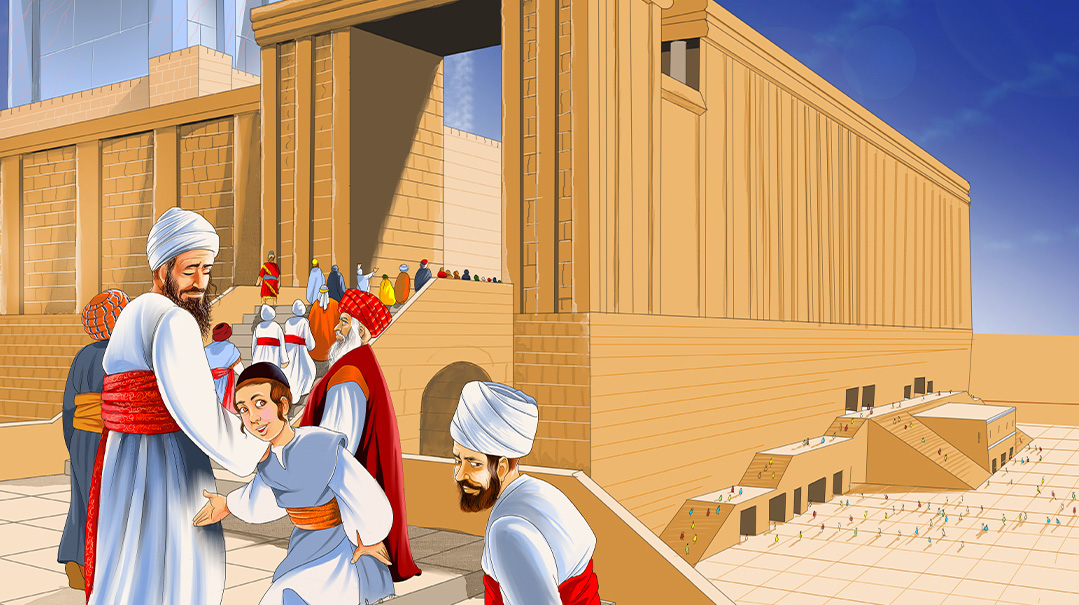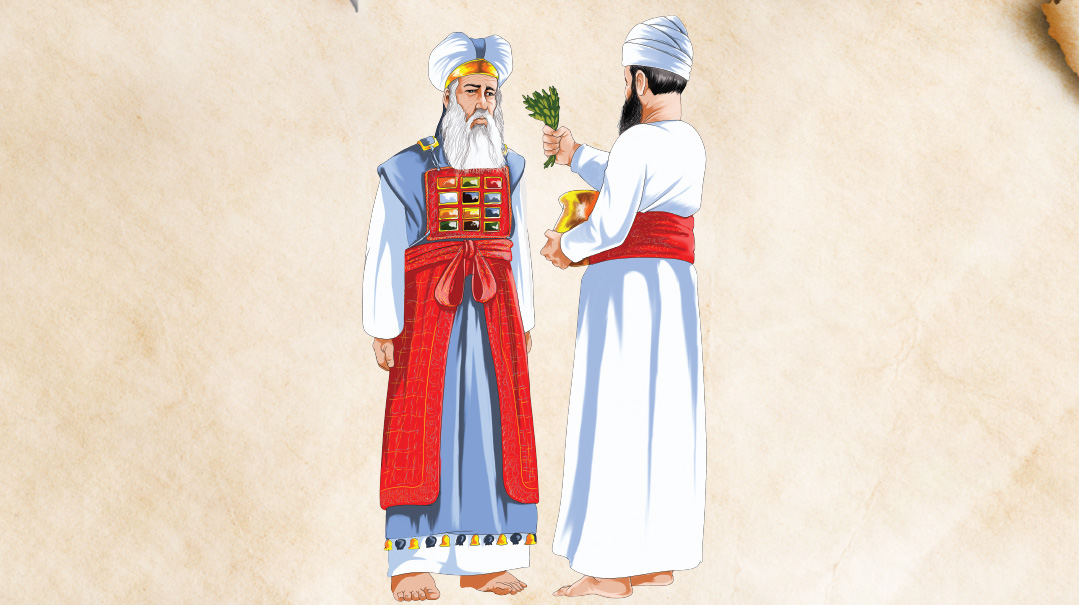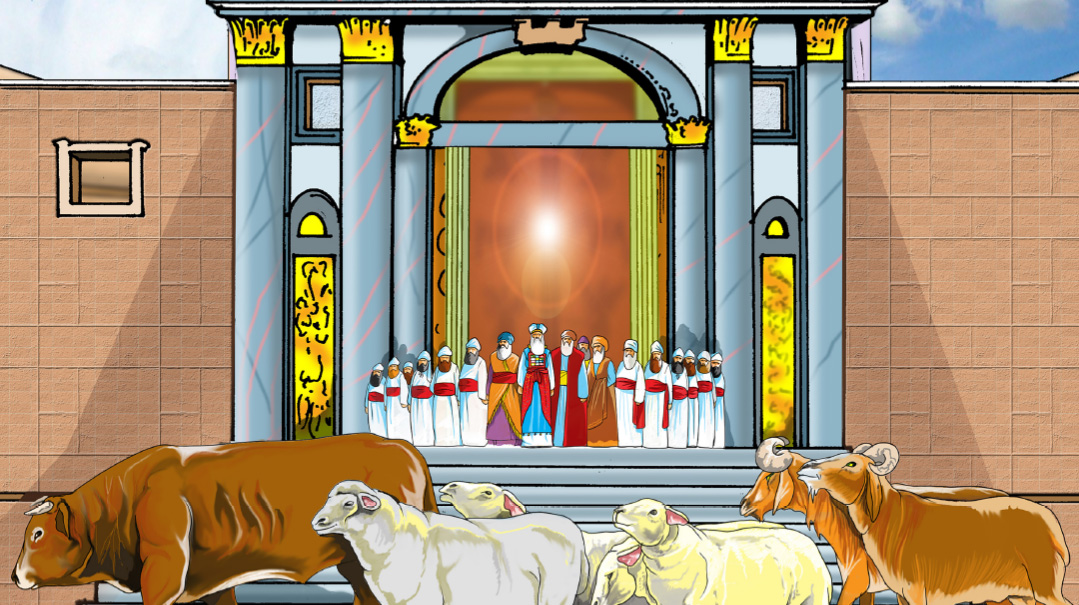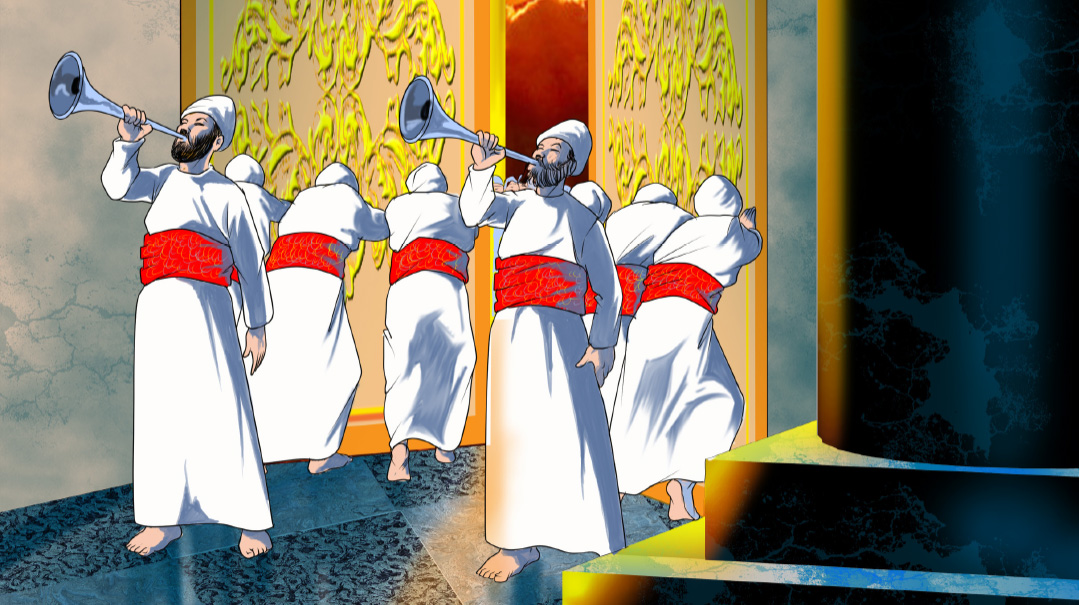Avodas Yom Hakippurim

A Beis Hamikdash Diary

Illustrations: Jacky Yarhi
2 Tishrei1
It’s Motzaei Rosh Hashanah and I’m exhausted but I can’t fall asleep. I’m way too excited, and nervous, too, to be honest. In a few days, Abba, Chilkiya, and I leave for the Mikdash, where we’ll stay until after Yom HaKippurim. Can you believe that my very first mishmar since becoming a bar mitzvah is the week of the holiest day of the year? Achituv is so envious, but his family’s mishmar will be on Succos, which is almost as exciting.
My very first mishmar! And my cousin Tzadok’s, too. Of course, since we’re only thirteen, Tzadok and I can’t be a part of the actual avodah yet, but you can bet we’ll be watching closely. Chilkiya is just as excited as I am. He’s done dozens of mishmarim already, but last week was his 20th birthday which means that now he can finally join in the avodah as a full-fledged Kohein.
Usually, the Kohanim of the beis av2 get to do a large part of the daily avodah. On Yom HaKippurim, however, the Kohein Gadol does most of it. But there is so much to do in the days leading up to Yom HaKippurim that all the Kohanim will have something to do. The more important tasks will probably go to the senior Kohanim, like Abba and the dodim. And of course, Saba — who, in addition to being our Rosh Beis Av, is the most senior of all the Kohanim. Some parts of the avodah are actually assigned with a goral. I hope Abba gets picked!
Tomorrow is the grand procession!
Now I really must get some sleep.
Lailah tov,
Azaryahu ben Shimon
[1]. There’s a machlokes about when the Kohein Gadol began his isolation. Some opinions say it began on Rosh Hashanah; others say it began on the day after Rosh Hashanah. (During the times of the Beis Hamikdash, Rosh Hashanah was just one day.)
[2]. The Kohanim were divided into 24 mishmaros, and each week there was a different mishmar in the Beis Hamikdash. The mishmaros were further divided into seven batei av, each of which was assigned one day of the mishmar to serve in the Beis Hamikdash. The Rosh Beis Av decided when each beis av would serve.
2 Tishrei
What a morning! I went with Abba and Chilkiya to the Kohein Gadol’s house. All the leaders of Am Yisrael were there, and many Kohanim. This year, Abba and Dod Achisamach let me and Tzadok join in honor of our first mishmar. The king, the Nasi, the Kohein Gadol, the Sgan HaKohanim and the Av Beis Din sat on the dais. The Sanhedrin sat on silver chairs facing them, while we Kohanim watched from the sides.
Saba, who is the eldest of all the Kohanim, spoke first. He warned the Kohein Gadol to have the proper kavanos while performing the avodah. Then he instructed the Kohein Gadol to do teshuvah.
The Kohein Gadol stood up and called out, “I have done teshuvah! I call upon you, my brothers the Kohanim: You, too, repent wholeheartedly!”
My heart fluttered when I heard his words. Yom HaKippurim will be upon us soon — have I done teshuvah properly? I should really ask Chilkiya to help me review the halachos.
The king spoke next, praising the Kohein Gadol. After that, someone outside announced, “The procession to the Lishkas Parhedrin will leave from the home of the Kohein Gadol three hours after chatzos hayom. Everyone is invited — men, women, and children.”
So now I’m waiting for Ima to finish braiding Rachel’s hair. Everyone is dressed in bigdei Shabbos and the procession is leaving in a few minutes. Literally everyone will be there — Kohanim, Leviim, Yisraelim, everyone! The royal family and the Zekeinim will be leading the way. We are all going to accompany the Kohein Gadol to his quarters in the Mikdash called the Lishkas Parhedrin. The Kohein Gadol will live there for the next seven days. He must isolate himself from outside distractions, and mentally prepare himself for avodas Yom HaKippurim.
Since it’s our family’s mishmar this week, we’ll be living in the Mikdash too. Ima, Rachel and baby Tirtza will miss us for sure, but I’ll be way too busy to be homesick.
I’d better run now.
Azaryahu ben Shimon

7 Tishrei
Whoa! I’ve been so busy; I’ve hardly had time to breathe. The Mikdash is such a magnificent compound, with loads of chambers and even underground tunnels. The place is massive! Did you know that there are lots of mikvaos here? We Kohanim must toivel before beginning any task in the Mishkan, and so there are mikvaos in every area of the Mishkan. There’s one in a room beneath the Beis Hamoked, which is the sleeping quarters of the Kohanim. And there are two that are used exclusively by the Kohein Gadol, one of which is used only on Yom HaKippurim.
There are tens of storage rooms. Animals, wood, oil, wine, flour — everything has its own storage room. There are also buildings within the Mikdash. The Lishkas Parhedrin, the Beis Hamoked, the Lishkas Beis Avtinas — these are just some of the buildings that are inside the Mikdash compound. I wish I could give you a grand tour of the Mikdash but it would take days!
Every day, Tzadok and I watch the Kohein Gadol as he practices for the avodah of Yom HaKippurim. In the morning of the third and seventh day3 before Yom HaKippurim, a Kohein sprinkles the Kohein Gadol with ashes from the parah adumah. The Zekeinim come to the Mikdash each day to review the halachos of the avodah with the Kohein Gadol. My favorite part is when Saba and the other senior Kohanim escort the Kohein Gadol from the Lishkas Parhedrin to the Lishkas Beis Avtinas. The Lishkas Beis Avtinas is where the famous Avtinas family prepares the Ketores. The Avtinas family are not kohanim, but they have a special mesorah for preparing the Ketores, and only they know the secret for making the smoke from the Ketores rise in a straight column. As part of the avodas hayom on Yom HaKippurim, the Kohein Gadol must perform the chafinas hakteores, which is pouring the Ketores from a machtah (a shovel) into his hands. This is one of the most difficult tasks to perform in the Mikdash. The senior members of the Avtinas family practice this skill with the Kohein Gadol every day, and I think he’s getting better at it. Two days ago, he was in the Lishkas Beis Avtinas for hours and hours. Today, he came out well before chatzos hayom.
It’s been such a long day. Tzadok is already fast asleep.
Lailah tov,
Azaryahu ben Shimon
[3]. According to the Rambam.
8 Tishrei
Let me tell you about Har Azazel and everything it involves. On Yom HaKippurim, two goats are brought before the Kohein Gadol, who performs a goral to choose which goat will be “l’Hashem” and which will “l’Azazel”. The goat for Hashem is offered as a korban, while the goat for Azazel is designated as the scapegoat for all the aveiros of Am Yisrael. A shaliach, called the Ish Iti, is chosen to take the goat to Har Azazel, where he will push it off a cliff. Har Azazel is in Midbar Yehudah, a distance of 12 mil from the Mikdash. That’s quite a journey to make in the heat of the day, and on a taanis, no less.
To make things easier for the Ish Iti, succos are constructed at every mil along the route. In the succos, the Ish Iti will be able to rest a little. They even prepare some food and drink, so the Ish Iti can break his taanis if he feels too weak. Abba tells me that so far, no Ish Iti has ever had to break his fast. There are also stone towers along the route. On Yom HaKippurim, watchmen will be stationed on the towers. Their job is to signal back to the Mikdash with a flag once the Azazel goat has been pushed off the cliff.
Tomorrow is Erev Yom HaKippurim, my family’s beis av. The entire Mikdash must be thoroughly cleaned and readied for the avodah. I can tell that Chilkiya is nervous, but that hasn’t stopped him from reminding me to drink every ten minutes. At this rate, I’ll turn into a camel.
Until tomorrow,
Azaryahu ben Shimon

9 Tishrei
This morning, all the Kohanim of the beis av gathered with Saba. He reviewed all the tasks that must be performed today. Chilkiya and some of the other cousins need to light all the lamps in the azarah, so that it can be inspected later. Tzadok and I will be helping Dod Shmaryahu to heat up cauldrons of water and long metal rods. If the water in the mikveh is too cold for the Kohein Gadol tomorrow, the attendants will have ready-heated water to add to it. The heated rods can be put into the mikveh as well.
Abba was tasked with pinning up the corners of the paroches to the Kodesh Hakodoshim. Yom HaKippurim is the only day of the year that the Kohein Gadol may enter the Kodesh Hokodoshim. There’s a double layer of paroches between the Kodesh Hakodoshim and the Heichal4. Since the Kohein Gadol will be carrying the Ketores and the coals in both hands, the parochos are pinned up to make it easier for the Kohein Gadol to pass through them. The parochos are very long and heavy, but Abba is strong so he’ll manage just fine.
Tzadok and I watched as the Kohein Gadol stood at Shaar Nikanor, the huge copper gates that are the main entrance to the azarah. All the animals that will be offered as korbanos were paraded in front of him. What a sight! Oxen and rams and sheep and goats. This chaotic parade helps the Kohein Gadol review the seder ha'avodah. Dod Achisamach spotted the two of us watching, so guess who was honored with the task of cleaning up all that animal dung?
The Kohein Gadol was then led to the Lishkas Beis Avtinas for the final time. Tzadok and I tried to peek inside, but we were shooed away. Chilkiya must have been in a generous mood, because he sat us down and explained what was going on in there.
The elders of the Beis Din officially designate the Kohein Gadol as their emissary for the purpose of the avodah. Then they make him swear not to change even one thing from their instructions. Unfortunately, the Beis Din was forced to institute this oath when the Tzedokim5 began making up their own “halachos.” Baruch Hashem, our Kohein Gadol is a yerei Shamayim who will surely follow the correct routine.
Tzadok and I were startled to hear loud sobs coming from Lishkas Beis Avtinas. Chilkiya told us that the Kohein Gadol was crying because the Beis Din suspected him of being a Tzedoki, and the members of the Beis Din were crying because maybe they were suspecting an innocent man.
I have to go help the cousins organize the Lishkas Osay Chavitin, which is where all the chavitin6 are prepared and baked.
Until later,
Azaryahu ben Shimon
[4] In the first Beis Hamikdash, there was a wall between the Heichal and the Kodesh Hakodoshim. When Bayis Sheini was built, they didn’t know if the wall had been inside the Heichal or inside the Kodesh Hakodashim, so they put up a paroches instead. There were two perochos so that when one of them was pinned up, one would not be able to look directly into the Kodesh Hakodashim.
[5]The Tzedokim were an influential sect, made up of kohanim and other important families, during the period of Bayis Sheini. They were influenced by the Hellenists, and became corrupt and blatantly went against halachah.
[6]The chavitin was a daily korban made from flour, oil, and water.

9 Tishrei
Soon, we’ll be eating the seudah hamafsekes. But before that, I’ve got to tell you what will take place on Yom HaKippurim.
Tonight, close to chatzos halailah, the memuneh7 will perform the goral for the task of terumas hadeshen. This is a huge honor. Abba was picked for this task two years ago, when our family’s beis av came out on Yom HaKippurim. I wonder who will be chosen this year.
Chilkiya showed me and Tzadok a loose tile in the floor of the Beis Hamoked. Underneath this tile is where the keys to the azarah are kept! After the goral, the memuneh takes the keys and unlocks one of the doors to the azarah. Then, the Kohanim perform the inspection of the azarah. They must make sure that the azarah is completely free of any tumah.
At daybreak, two Kohanim blow silver trumpets to herald the beginning of the avodah. The Leviim open all the doors to the azarah, and Am Yisrael piles into the Mikdash. What a sight to behold! B’rov am hadras Melech!
At this point, the Kohein Gadol is almost ready to begin the avodah.
But we’re not up to all that just yet. Did you know that the Kohein Gadol must stay awake the entire night of Leil Yom HaKippurim? This is to make sure that he doesn’t accidentally become tamei. A group of young Kohanim will go to the Lishkas Parhedrin to keep the Kohein Gadol awake, and Chilkiya said that Tzadok and I can come! The Kohein Gadol spends the whole night teaching halachah. If he starts to nod off, the Kohanim snap their fingers to wake him up. But you have to snap your thumb and forefinger together8, and let me tell you — it’s really hard. I’ve been practicing all year and I can barely crack a sound. You should hear Chilkiya do it, though.
The Holy Day is approaching, and I must get ready. Chilkiya is already dressed in his new bigdei Kehunah. B’ezras Hashem, on Motzaei Yom HaKippurim I’ll be able to tell you all about it.
Gmar chasimah tovah!
Azaryahu ben Shimon
[7] Memuneh: a Kohein who acts as a team leader.
[8] This is a machlokes. Some opinions hold that they snapped their fingers as above, while others say that they snapped their thumb and middle finger like we do today.

11 Tishrei
I don’t even know where to begin. It was such an emotional day, but now I feel like I’m floating! B’chasdei Hashem, the ribbon turned white; our teshuvah was accepted! I’m so relieved and happy. But I’m getting way ahead of myself here.
There were so many highlights during the day, one of which was when Tzadok and I joined the duchan for the first time! Now I really feel grown up.
The Kohein Gadol immersed in the mikveh and donned his Bigdei Zahav. I just love seeing him in those colorful begadim. Then he proceeded to do the Korban Tamid and the Mussafim. The Nisuch Hayayin9 is one my favorite parts of the korbanos. It’s always very joyous. The Leviim play instruments and sing the Shir Shel Yom.
When the Kohein Gadol appeared outside the mikveh wearing the Bigdei Lavan, a hush descended on the crowd. I trembled when I saw him all dressed in white — he looked like a malach.
The Kohein Gadol placed his hands on the head of the bull and proceeded to say Vidui. He was crying so hard, you could barely hear him say “Chatasi, avisi, pashati lefanecha.” Of course, everyone else was crying, too. When he said Shem Hameforash, we all fell on our faces.
Everyone roared, “BARUCH SHEIM KEVOD MALCHUSO L’OLAM VA’ED!”
It felt like the whole world was shaking. I was so frightened, I thought I would never be able to get up again.
You know what else was nerve-racking? Just before the Kohein Gadol went into the Kodesh Hakadashim with the Ketores, a Kohein tied a gold rope around his ankle so that if he died in there, they could pull his body out10. I was so scared, but I guess the chafinas haketores went okay because the Kohein Gadol emerged alive and well. I don’t think I was the only one who breathed a sigh of relief! He went into the Kodesh Hakodoshim three more times during the day, and each time was just as frightening.
When he disappeared into the Heichal with the blood of the karbanos, everyone was silent because we all wanted to hear him say “Achas, achas v’achas,” and so on, but obviously he was too far away for us to hear.
The absolute best part of the day was after the fifth and final tevilah, when the Kohein Gadol appeared on the balcony of the Lishkas Haparvah in his own Bigdei Shabbos. By then, the stars were already in the sky and my stomach was rumbling. The Kohein Gadol stood there, his face shining — I’ve never seen anything like it. Then, everyone — even the king — escorted him back home, singing and dancing all the way.
Abba, Chilkiya, and I hurried home to make Havdalah. Let me tell you, there’s nothing better than biting into a juicy date after a taanis!
And now, I must help Chilkiya build the succah.
Until next time,
Azaryahu ben Shimon
[9] Nisuch Hayayin: Every korban was offered together with a Minchah and Nisuch Hayayin. The Minchah was flour and oil, and the Nisuch Hayayin was when wine was poured through a specific hole on the mizbeiach.
[10]According to the Zohar.
(Originally featured in Mishpacha Jr., Issue 930)
Oops! We could not locate your form.






